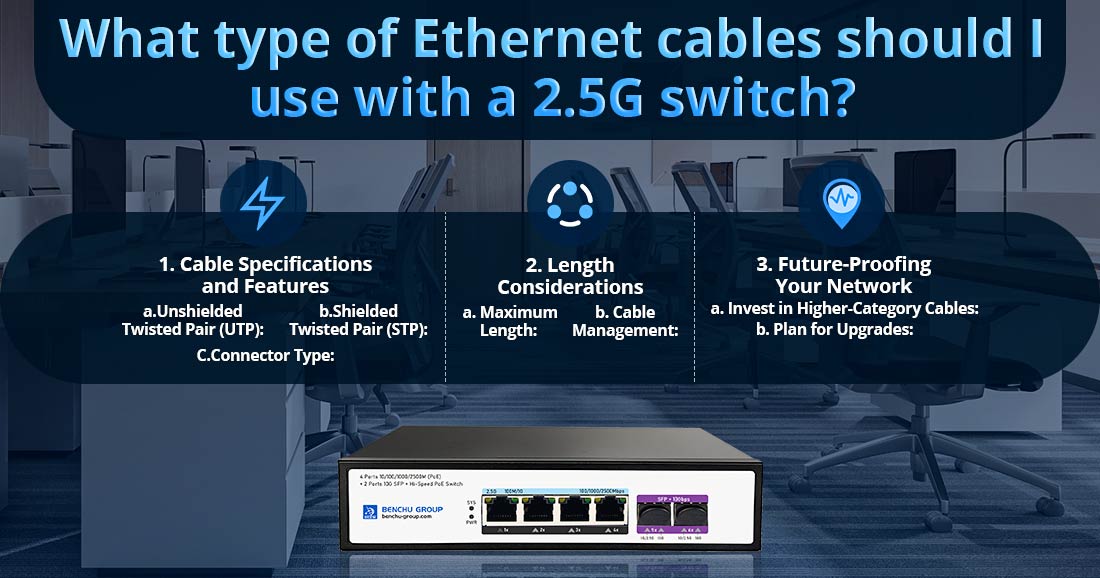
When selecting Ethernet cables for use with a 2.5G switch, it's essential to choose cables that can support the higher data rates associated with 2.5 Gigabit Ethernet. Here’s a detailed description of the types of Ethernet cables suitable for this purpose:
1. Recommended Ethernet Cable Types
Category 5e (Cat 5e):
--- Overview: Cat 5e is an enhanced version of the original Cat 5 cable. It is designed to reduce crosstalk (interference from adjacent wires) and can handle higher speeds.
--- Performance: Supports speeds up to 1 Gbps (Gigabit Ethernet) over distances up to 100 meters (328 feet).
--- Use with 2.5G Switch: Cat 5e cables can technically support 2.5G Ethernet under certain conditions, particularly if the cable runs are short (generally less than 100 meters). However, they are not the optimal choice for future-proofing or consistently high performance at 2.5G speeds.
Category 6 (Cat 6):
--- Overview: Cat 6 cables are designed for high-speed networking and provide better performance than Cat 5e cables.
--- Performance: Supports speeds up to 10 Gbps over distances up to 55 meters (180 feet) and 1 Gbps up to 100 meters.
--- Use with 2.5G Switch: Cat 6 is an excellent choice for 2.5G switches, as it can consistently support higher speeds without issues related to crosstalk and interference. It is suitable for both short and long runs.
Category 6a (Cat 6a):
--- Overview: Cat 6a is an augmented version of Cat 6 and is designed for even higher performance.
--- Performance: Supports speeds up to 10 Gbps over distances of up to 100 meters (328 feet) with improved shielding.
--- Use with 2.5G Switch: Cat 6a cables are highly recommended for 2.5G switches, especially in environments with high electromagnetic interference (EMI) or where cable runs exceed typical lengths. They provide robust performance, reducing crosstalk and signal degradation.
Category 7 (Cat 7) and Category 8 (Cat 8):
--- Overview: Cat 7 and Cat 8 cables are designed for high-speed data transmission and have enhanced shielding and performance characteristics.
--- Performance: Cat 7 supports speeds up to 10 Gbps at distances of 100 meters, while Cat 8 can handle speeds up to 25 Gbps to 40 Gbps over distances up to 30 meters (98 feet).
--- Use with 2.5G Switch: While both are overkill for 2.5G Ethernet, they are fully compatible and can provide future-proofing if you anticipate upgrading to higher-speed networks. They are ideal for data centers or environments with significant cabling demands.
2. Cable Specifications and Features
Twisted Pair Configuration: All the recommended cables are twisted pair cables, which means that pairs of wires are twisted together to reduce interference. This design is crucial for maintaining signal integrity, especially at higher speeds.
Shielding:
--- Unshielded Twisted Pair (UTP): Most common and sufficient for many applications, especially in low-interference environments.
--- Shielded Twisted Pair (STP): Provides additional shielding to protect against EMI. This is particularly useful in industrial environments or areas with many electronic devices.
--- Connector Type: Ensure that the cables have RJ45 connectors, which are standard for Ethernet networking. These connectors are compatible with most networking devices, including switches, routers, and network interface cards.
3. Length Considerations
Maximum Length: The maximum length for Ethernet cables is typically 100 meters (328 feet) for reliable performance. However, for optimal performance at 2.5G speeds, it’s best to keep lengths shorter when using Cat 5e or Cat 6 cables.
Cable Management: Plan your cabling layout to minimize the distance between devices where possible. Using shorter cables can reduce latency and potential signal degradation.
4. Future-Proofing Your Network
When setting up a network with a 2.5G switch, it’s wise to consider future needs. Here are a few tips:
--- Invest in Higher-Category Cables: Opting for Cat 6 or Cat 6a cables allows for better performance and future scalability. They are not significantly more expensive than Cat 5e and offer much better performance and reliability.
--- Plan for Upgrades: If you anticipate needing higher bandwidth in the future (e.g., upgrading to 10G), consider using Cat 6a or Cat 7 cables from the start.
Conclusion
In summary, while Cat 5e cables can work with a 2.5G switch under optimal conditions, it is advisable to use Cat 6 or Cat 6a cables for consistent performance, reliability, and future-proofing. Cat 6a and Cat 7 cables offer additional benefits in terms of shielding and performance, making them suitable for high-demand environments. By selecting the appropriate Ethernet cables, you can ensure your network operates efficiently and effectively, supporting your 2.5G switch and connected devices.